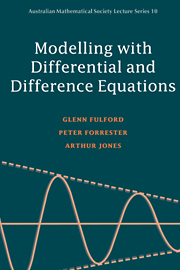Book contents
- Frontmatter
- Contents
- Preface
- Introduction to the student
- Part One Simple Models in Mechanics
- Part Two Models with Difference Equations
- Part Three Models with Differential Equations
- Part Four Further Mechanics
- Part Five Coupled Models
- 18 Models with linear interactions
- 19 Non-linear coupled models
- References
- Index
18 - Models with linear interactions
Published online by Cambridge University Press: 05 June 2012
- Frontmatter
- Contents
- Preface
- Introduction to the student
- Part One Simple Models in Mechanics
- Part Two Models with Difference Equations
- Part Three Models with Differential Equations
- Part Four Further Mechanics
- Part Five Coupled Models
- 18 Models with linear interactions
- 19 Non-linear coupled models
- References
- Index
Summary
In this chapter we look at simple models in which two quantities interact with each other. The models lead to pairs of simultaneous differential equations for the two quantities and, because of the interaction, the equations are coupled.
The models considered will be simple enough to produce differential equations which are first-order linear, with constant coefficients. A systematic method for uncoupling – and hence solving – such equations will be explained. It involves eliminating one of the two quantities to give a second-order differential equation of the type studied in Chapter 15.
The ideas will be illustrated by a mixing model, similar to the one in Chapter 13, but involving a pair of vats. Two models from physiology are then presented: the first models the glucose-insulin homeostasis in the bloodstream, while the second models the mother-fetus exchange of nutrients via the placenta.
Two-compartment mixing
From now on we shall be considering models which lead to a pair of simultaneous differential equations, rather than a single differential equation. The equations will involve a pair of quantities, rather than a single quantity, which are to be expressed as functions of the time, say. In this section we show how an extension of the mixing problem discussed in Chapter 13 leads to such a pair of equations.
Mixing with two vats
Consider two interconnected vats, each containing a mixture of dye and water, as in Figure 18.1.1. Dye runs into the first vat.
- Type
- Chapter
- Information
- Modelling with Differential and Difference Equations , pp. 355 - 378Publisher: Cambridge University PressPrint publication year: 1997

